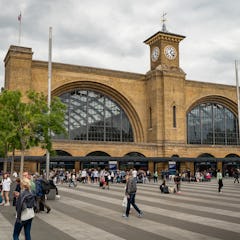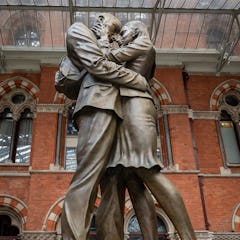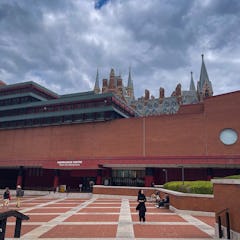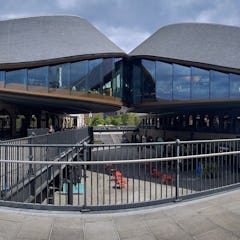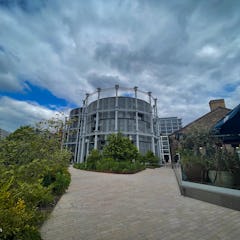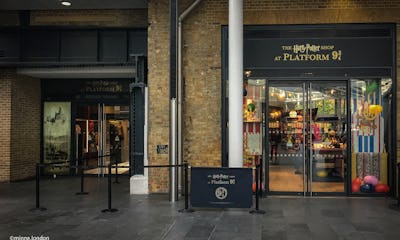King’s Cross is one of London’s most striking examples of complete urban renewal. Just a few decades ago, this area built around the railway stations was known mainly as an industrial zone and a place people passed through. Today, King’s Cross is a modern, architecturally fascinating and vibrant neighbourhood where history, culture and sustainable urban design meet. Former warehouses and canal buildings have found new life as restaurants, galleries and creative hubs, making the area popular with both locals and visitors.
History of King’s Cross
The name King’s Cross originates from a monument dedicated to King George IV, built in 1830 at the junction of Gray’s Inn Road, Pentonville Road and what is now Euston Road. Designed by architect Stephen Geary, the structure was topped with a statue of the king but was demolished in 1845. The name, however, lived on.
Originally a rural area, King’s Cross developed rapidly into an industrial hub in the mid-1800s. Its location along the Regent’s Canal made it a key centre for transport and goods distribution, leading to the construction of warehouses, coal depots and major railway infrastructure. These projects transformed King’s Cross into one of Victorian London’s most important industrial districts, defined by functional architecture and efficiency.
Architecture and Regeneration
The train stations, King’s Cross and St Pancras International, shaped the district’s identity. King’s Cross Station, by architect Lewis Cubitt, and the Gothic-revival St Pancras Hotel and train station, by Sir George Gilbert Scott and engineer William Henry Barlow, became architectural landmarks linking London to northern England and Europe.
In the 2000s, King’s Cross underwent one of Europe’s most significant regeneration projects. The plan combined industrial heritage with contemporary architecture, creating an energy-efficient, walkable and community-minded neighbourhood. Today, it stands as a model of modern urban planning.
St Pancras International and King’s Cross Station Highlights
Inside St Pancras International, visitors can admire the blend of modern and historic architecture. The station features a vast glass-roofed hall where Eurostar trains depart for Paris, Brussels and other European cities. Public art is a key feature of the station.
At its centre stands The Meeting Place, a nine-metre bronze sculpture by Paul Day depicting an embracing couple — a symbol of reunions and journeys. Other highlights include Martin Jennings’ statue of poet John Betjeman, gazing up at the roof in tribute to his efforts to save the station in the 1960s, and Tracey Amin’s pink neon piece I Want My Time With You, whose tender message glows above the Eurostar platforms. The station also hosts the Terrace Wires series, showcasing rotating contemporary art installations.
The St Pancras clock has a story of its own: the original 19th-century clock was sold to a private collector in the United States in the 1970s and broke into pieces during removal. Retired train driver Roland Hoggard saved the fragments, which were later used as a model when clockmaker Dent created a replica for the station’s 2007 restoration — part of an £800-million refurbishment.
At neighbouring King’s Cross Station, the Harry Potter-themed Platform 9¾ delights fans with its trolley-through-the-wall photo spot, where you can get a photo taken by one of the site’s photographers, and a themed shop.
The station and its surroundings also feature several notable artworks, including the bronze statue of Sir Nigel Gresley, which honours the celebrated steam locomotive designer. The Full Circle sculpture (2009) adorns the Underground concourse, while the impressive Light Tunnel connects King’s Cross and St Pancras towards Granary Square and Coal Drops Yard, through a vividly illuminated passage.
Digital projections from the Art on the Underground programme enhance the environment with contemporary visual art, and outside, The Outside Art Project introduces rotating sculptures and art benches to public spaces, making King’s Cross one of London’s leading outdoor art destinations.
Top Attractions and Culture near King’s Cross
Just steps away lies the British Library, home to treasures such as Magna Carta and Shakespeare’s First Folios.
At the heart of the redevelopment lies Coal Drops Yard, a shopping and leisure district designed by architect Thomas Heatherwick. Former coal warehouses have been transformed into a stunning complex of design shops, galleries and restaurants, where historic brick structures meet modern steel and glass. The curving rooftops have become an architectural landmark of the area.
Nearby, Granary Square is a large public plaza animated by hundreds of water jets. It’s a favourite with children in summer, and a lively meeting place that also hosts cultural and community events throughout the year.
Nearby galleries, pop-up exhibitions and the House of Illustration (now part of the Quentin Blake Centre for Illustration) add creative flair.
In summer, the Screen on the Canal open-air cinema by the Regent’s Canal steps is a local favourite.
Lightroom and Innovation Spaces
On Lewis Cubitt Square, near Coal Drops Yard, stands Lightroom, a venue for immersive digital exhibitions that combine projections, sound and moving image. Productions like Prehistoric Planet: Discovering Dinosaurs and The Moonwalkers: A Journey with Tom Hanks have gained international acclaim.
King’s Cross is also home to Google’s new UK headquarters, nicknamed the “landscraper.” Designed with sustainability in mind, the building features rooftop gardens that provide habitats for bees and other wildlife.
Parks and Green Spaces in King’s Cross
Despite its industrial past, King’s Cross is surprisingly green. At its heart lies the Camley Street Natural Park, a peaceful oasis by the Regent’s Canal where visitors can spot birds, insects and aquatic plants in a central London setting. Created in the 1980s, it remains a prime example of how urban nature can thrive amid dense development.
A scenic Regent’s Canal Walk connects King’s Cross with Camden Town and Little Venice, offering peaceful views of boats, modern apartments and waterfront cafés.
Restaurants and Food Scene
King’s Cross has a diverse and ever-expanding food scene. Around Coal Drops Yard and Granary Square, visitors will find a range of dining options, from relaxed eateries to fine dining. Highlights include Dishoom King’s Cross, serving modern Indian cuisine in a converted warehouse, and Barrafina, known for its authentic Spanish tapas. Next to the stations, The German Gymnasium serves classic German dishes and beer in a grand setting.
You’ll also find global cuisine from Vietnam, Mexico and the Middle East, many with terraces overlooking the canal, perfect for al fresco dining or a few drinks.
Food Markets and Local Flavours
Food lovers shouldn’t miss the Canopy Market, a covered artisan market beside Granary Square offering street food, local produce and crafts from Wednesday to Sunday.
The Real Food Market in front of the station serves gourmet lunches Tuesday to Friday, while the Lower Stable Street Market under Coal Drops Yard combines food, fashion and design every weekend.
Hotels in King’s Cross
King’s Cross has seen significant growth in accommodation options in recent years. The most iconic hotel in the area is the red-brick St Pancras Renaissance Hotel, located within the station complex. Its grand façade also featured in the Harry Potter films. The Standard, London, situated in a former town hall opposite St Pancras, features boutique-style design and offers panoramic views from its top-floor restaurant. Nearby, the Great Northern Hotel, dating back to the 1850s, has been beautifully restored, blending Victorian elegance with contemporary comfort — a stylish stay just steps from the mainline and international rail connections.
Getting Around and Practical Tips
The King’s Cross St Pancras transport hub connects six Underground lines plus national and international rail. The district is highly walkable, and its canal-side paths are ideal for cycling.
Year-round events, outdoor exhibitions and food festivals keep the atmosphere lively and ever-changing, making King’s Cross one of London’s most dynamic destinations.
Why Visit King’s Cross?
King’s Cross is where history, creativity and sustainable design intersect. Explore the shops of Coal Drops Yard, relax by the fountains of Granary Square, enjoy craft food at Canopy Market, and experience the immersive shows at Lightroom.
With its central location, excellent transport links and blend of culture and innovation, King’s Cross represents the new face of London: energetic, inclusive and endlessly inspiring.
